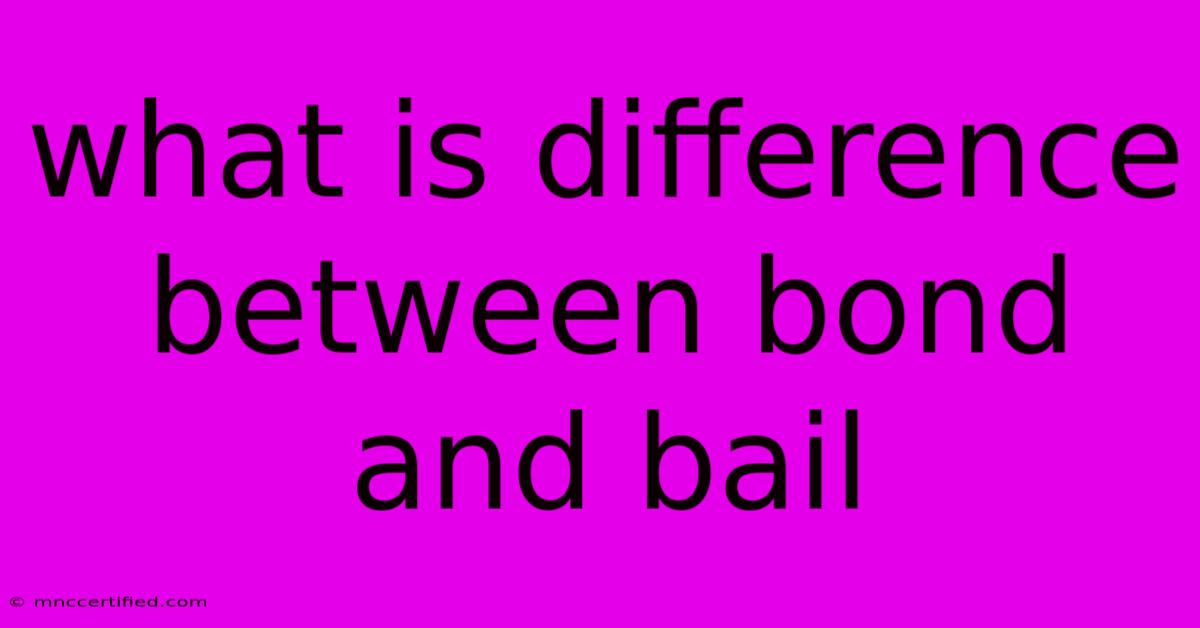What Is Difference Between Bond And Bail

Table of Contents
What's the Difference Between Bond and Bail?
The terms "bond" and "bail" are often used interchangeably, but they actually represent different aspects of the legal process. While they both involve financial guarantees, they serve distinct purposes and are handled in varying ways. This guide will help you understand the key distinctions between bond and bail, ensuring you have a clear grasp of the legal jargon.
Understanding the Basics: Bond vs. Bail
Bail refers to the money or property used as a guarantee for the release of an arrested person pending trial. It is a temporary measure, ensuring the accused's appearance in court for subsequent hearings. If the individual appears as scheduled, the bail money is returned.
Bond is a written agreement between the accused and the court, backed by a financial guarantee. It acts as a security measure, ensuring the accused's attendance in court. Bonds are typically handled by a bail bondsman who charges a fee, usually a percentage of the bond amount, for providing the financial guarantee.
Key Differences Explained
Here's a breakdown of the crucial distinctions between bond and bail:
| Feature | Bail | Bond |
|---|---|---|
| Purpose | To secure the release of the accused pending trial | To ensure the accused's appearance in court |
| Financial Guarantee | Money or property | Bond amount |
| Release Mechanism | Paid directly to the court | Paid to a bail bondsman |
| Refund | Full refund if the accused appears in court | Refund depends on the bond agreement |
| Liability | Defendant is fully responsible for the bail amount | Defendant is liable only if they fail to appear |
| Fee | No fee | Fee charged by the bail bondsman |
| Court Involvement | Court sets the bail amount | Court typically approves the bond amount |
Scenario Example:
- Bail: A person is arrested for DUI and the judge sets bail at $5,000. The defendant's family pays the $5,000 to the court. The defendant is released. If they appear in court for all scheduled hearings, the $5,000 is returned.
- Bond: A person is arrested for drug possession and the court sets the bond at $10,000. The defendant contacts a bail bondsman who agrees to post the $10,000 bond for a fee of 10%. The defendant pays the bail bondsman $1,000 and is released. If the defendant fails to appear in court, the bail bondsman is liable for the $10,000 and will pursue the defendant to recover their losses.
Navigating the Legal System: Understanding the Difference Matters
Knowing the difference between bond and bail is crucial for understanding the legal process and your rights. If you are arrested or have a loved one facing charges, understanding the options available and the financial implications is essential.
For accurate legal guidance, it is always recommended to consult with an attorney who can provide expert advice tailored to your specific situation.
Remember: This article is meant to provide general information and does not constitute legal advice. Always consult with a qualified attorney for any legal questions or concerns.

Thank you for visiting our website wich cover about What Is Difference Between Bond And Bail. We hope the information provided has been useful to you. Feel free to contact us if you have any questions or need further assistance. See you next time and dont miss to bookmark.
Featured Posts
-
How Often Does Insurance Cover Pump Parts
Nov 07, 2024
-
Redwood Fire And Casualty Insurance Company
Nov 07, 2024
-
Does Medical Insurance Cover Atv Accidents
Nov 07, 2024
-
Bleak Downtowns Push California Crime Reform
Nov 07, 2024
-
Live Cricket West Indies Vs England Odi
Nov 07, 2024